

6/2006
New waterfront park emphasizes revitalization of downtown Houston

by Russell Boniface
Associate Editor
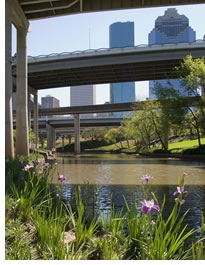 Linda Ronstadt once sang softly that she “was going back some
day, come what may, to Blue Bayou.” Now is her chance. And, for
Houstonians, it is their chance too.
Linda Ronstadt once sang softly that she “was going back some
day, come what may, to Blue Bayou.” Now is her chance. And, for
Houstonians, it is their chance too.
The once-murky Buffalo Bayou, Houston’s principal waterway, is now turning blue—and its surrounding landscape is turning natural green. The Buffalo Bayou and downtown Houston are in the midst of a 20-year, $800 million beautification and redevelopment plan, masterminded by the nonprofit Buffalo Bayou Partnership, an amalgam of public and private partners, and the City of Houston. Launched in 2002, the Buffalo Bayou “master plan,” entitled Buffalo Bayou and Beyond, aims to reclaim Houston’s waterfront by creating parks, urban destinations, canals, and mixed-use developments.
This month, its centerpiece project was completed: a 23-acre downtown park segment of the bayou called the Sabine-to-Bagby Promenade, designed by the SWA Group. The $15 million linear park combines recreation, culture, and nightlife. The promenade’s signature element, however, are cobalt blue and white lights that line the entire length of the park at night and illuminate the bayou. The blue and white lights shift with the phases of the moon. It is meant to signify the dramatic change in Houston as it hopes to revitalize its landscape and attract development. On June 10, the Buffalo Bayou Partnership held its promenade grand opening ceremony, called “Blue Bayou,” with a night of music, artistic films “floating” on a bayou movie screen, and spectacular fireworks—all the while awash in blue lights. Now that Sabine-to-Bagby Promenade is open, the Buffalo Bayou Partnership hopes it will be an “urban oasis for hiking, biking, picnicking, nature walks, raising spirits, and having fun.”
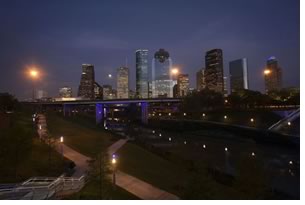 Buffalo Bayou defines Houston
Buffalo Bayou defines Houston
But first . . . what is Buffalo Bayou? And just how did it get its name?
Did woolly buffalo once thunder up and down its banks? And . . . just
what is a bayou?
Buffalo Bayou has defined Houston’s geography and shipping industry since the city was founded in 1836. It begins on the west side of the city and flows east to the Houston Ship Channel, which today is part of the Port of Houston, one of the country’s busiest seaports, because it is a conduit between the continental interior and the Gulf of Mexico.
Although there is a history of buffalo once roaming along the bayou, Houston historians are uncertain of the exact origin of the name. But all offer the same two theories:
- Buffalo fish, a friendly looking group of hump-back marine life, is prevalent in the bayou
- Archeologists have excavated bison bones at several locations along the Buffalo Bayou, indicating that Native Americans drove buffalo over the steep banks to make them easy targets for their spears. (Many Houstonians, not surprisingly, choose the former explanation.)
A bayou is not quite a river. A bayou is a small, shallow, gentle, slow-moving
stream or creek, usually located in low-lying southern states like Texas.
The word “bayou” was first used by the French in Louisiana
and is thought to originate from the Native-American word bayuk, which
means small stream.
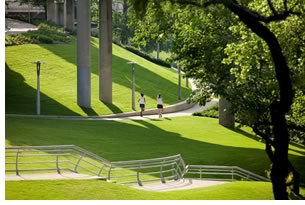 Buffalo Bayou redux
Buffalo Bayou redux
After once being considered an environmental gem, the Buffalo Bayou developed
a poor public image due to unsustainable development, pesticide contamination,
oil runoff, and other contaminates. Despite cleanup efforts, pedestrians
who wanted to stroll along its banks often found that trails or walkways
would abruptly end. As a result, the Buffalo Bayou was infrequently
visited or used. In 2002, the Buffalo Bayou Partnership and the City
of Houston set out to bring Buffalo Bayou back to life with a 20-year
master plan.
The plan focuses on a 10-square-mile district that will create 850 acres of new park land with improved pedestrian access to and along the bayou. A network of trails and public sites will reconnect neighborhoods to the waterway while widening the bayou at select locations and will give the bayou a more visible focus within Houston. The city then hopes to attract 25 million square feet of mixed-use development, create attractions such as boat landings and the planned Symphony Island Performance Center, and improve transit corridors.
The plan also calls for adaptive reuse of historical and former industrial sites and restoration of damaged environmental resources. An important piece of the puzzle, however, was solving the bayou’s flooding concerns, which had hindered any previous development. The answer came in the form of 14,000 tons of rock to create a sustainable, anti-erosion bulkhead along the water’s edge, which also contributes to an improved storm water capacity. When Houston’s 20-year plan to redevelop Buffalo Bayou into a pedestrian-oriented, urban-destination waterfront was unveiled in 2002, it received an Excellence on the Waterfront Honor Award by the Waterfront Center, a Washington, D.C.-based public interest advocacy group dedicated to waterfront development around the world.
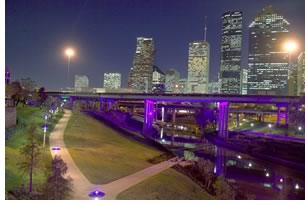 A scenic, urban waterfront park
A scenic, urban waterfront park
One of the first major projects of the Buffalo Bayou master plan is finished:
Sabine-to-Bagby Promenade, a 23-acre park in the heart of Houston that
is now the cornerstone of the bayou and the downtown revitalization.
The park was designed by the SWA Group and named for its location between
Houston’s Sabine and Bagby streets, Sabine-to-Bagby Promenade.
It features lush greenery and gardens, pedestrian walkways, two miles
of hiking and biking trails, an artistic blue and white lighting system,
canoe launches, public art sculptures, and a pedestrian bridge that
crosses the bayou.
The lush new park features 300,000 plants and 600 native trees, many of which line the trails for shade and line the banks to stabilize erosion. There is plenty of open lawn space with adjacent flower beds and shade gardens. Since the layout of the park has heavily shaded areas under freeway overpasses, combined with steep bayou banks, each area was landscaped with plants and trees appropriate to the area with long-term sustainability in mind. For example, three native, evergreen plants were specifically selected for the banks because they will bloom through Houston’s hot summer, despite the heat, and also tolerate flooding.
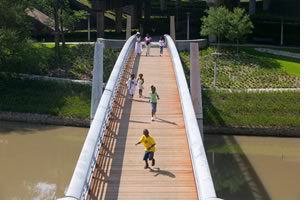 New accessibility to the park
New accessibility to the park
Sabine-to-Bagby Promenade includes 12 new entry points to the park. These
include stairs, decorative lighting, and landscaping. Five of the entries
are called portals and invite visitors into the park. Each portal has
a raised 20-foot, stainless steel, upside-down canoe sculpture that
serves as a bayou landmark, inviting visitors to pass under as they
enter. Houston artist John Runnels designed the boat sculptures. “In
all cultures, the boat symbolizes journey,” he says. “The
open boat form, especially the unfinished form, is indicative of the
fragility of life. The upside down canoe form provides something to
walk under, something to walk through, and something to walk past.”
An elegant steel and concrete pedestrian bridge provides access to both banks of the promenade and links with the nearby Hobby Center for the Performing Arts and downtown theater district. The landings on both sides of the bridge are lushly landscaped with native plantings. The bridge—189 feet long and 10 feet wide—allows pedestrians to walk, jog, or bike a complete loop around the bayou without having to cross any busy streets. “We designed the bridge to highlight an industrial aesthetic while making the pedestrian crossing safe and accessible,” says Kevin Shanley, president of SWA Group. “Most of our architects are themselves bikers and joggers, and their input was invaluable in this process. I’m proud of the result and look forward to using the bridge.”
Anne Olson, president of the Buffalo Bayou Partnership, is very pleased with SWA’s design.“The goal for all our bayou parks is to give bikers and walkers better access to the park’s amenities, but safe and well-located bayou crossings are key,” she says. “We are pleased with the way it captures the appearance of the downtown waterfront.”
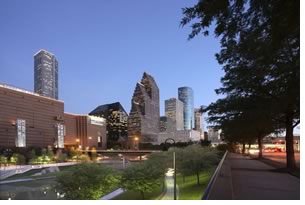 By the light of the moon
By the light of the moon
The signature design element of the promenade is the spectacular blue
and white light pattern, designed by New York City-based architect
Stephen Korns and New-York-based lighting firm L’Observatoire,
which illuminates park, trails, and water. Each light fixture contains
a glowing LED orb that creates light ribbons changing from white to
blue to white again, following the moon’s 29.5-day cycle. On
each full moon, all lights will be white, and then, traveling from
east to west, progressively change to blue until they are all blue
on the new moon. At this point, the pattern will repeat, this time
changing to white as the moon grows again to full. Blue lighting underneath
the bayou bridge on its columns will reinforce this pattern. There
are also additional blue and white lighting of trees, walls, and the
bridge walkway, all to help brighten the park, reveal more of the bayou
at night, and provide safety. In all, the lights symbolize downtown
Houston’s rebirth and its stronger connection to its land. The
lights are also meant to give the downtown a more distinctive identity.
Gateway to downtown
The Buffalo Bayou Partnership is continuing its leadership in developing
its long-range master plan to upgrade the Buffalo Bayou, the natural
surrounding landscape, and the economy of downtown Houston through
development. Sabine-to-Bagby Promenade is considered the “jewel” of
that master plan. “This area of Buffalo Bayou is essential to
the revitalization of the entire corridor—it is the gateway to
downtown,” explains Mike Garver, incoming chair of the Buffalo
Bayou Partnership. “The new park exemplifies our vision for Buffalo
Bayou and adds to the waterway’s visual appeal and pedestrian
access for all Houstonians.”
Adds Olson, “This project exemplifies the strength that public and private partnerships bring to redevelopment efforts.”
And with its dramatic blue lighting, it is likely that you will never be blue on this bayou.
Copyright 2006 The American Institute of Architects.
All rights reserved. Home Page ![]()
![]()
Did you know ...
• Early settlers who came to this region staked their hopes and
fortunes on an opportunity to make Buffalo Bayou their “river of
dreams.”
• Houston has a herd of street names that begin with Buffalo, e.g.,
Buffalo Bend Drive, Buffalo Ridge Circle, and Buffalo Terrace.
• Looking for an affordable Texas piece of land to establish a city,
businessmen Augustus and John Allen took surveys up and down the Buffalo
Bayou in a canoe until they found 6,600 acres of land with the right
price tag—$5,000. On August 26, 1836, Houston was born.
• Houston is named after Sam Houston, a key figure in the history
of Texas, including periods as president of the Republic of Texas, U.S.
senator for Texas after it joined the Union, and finally as governor.
![]()